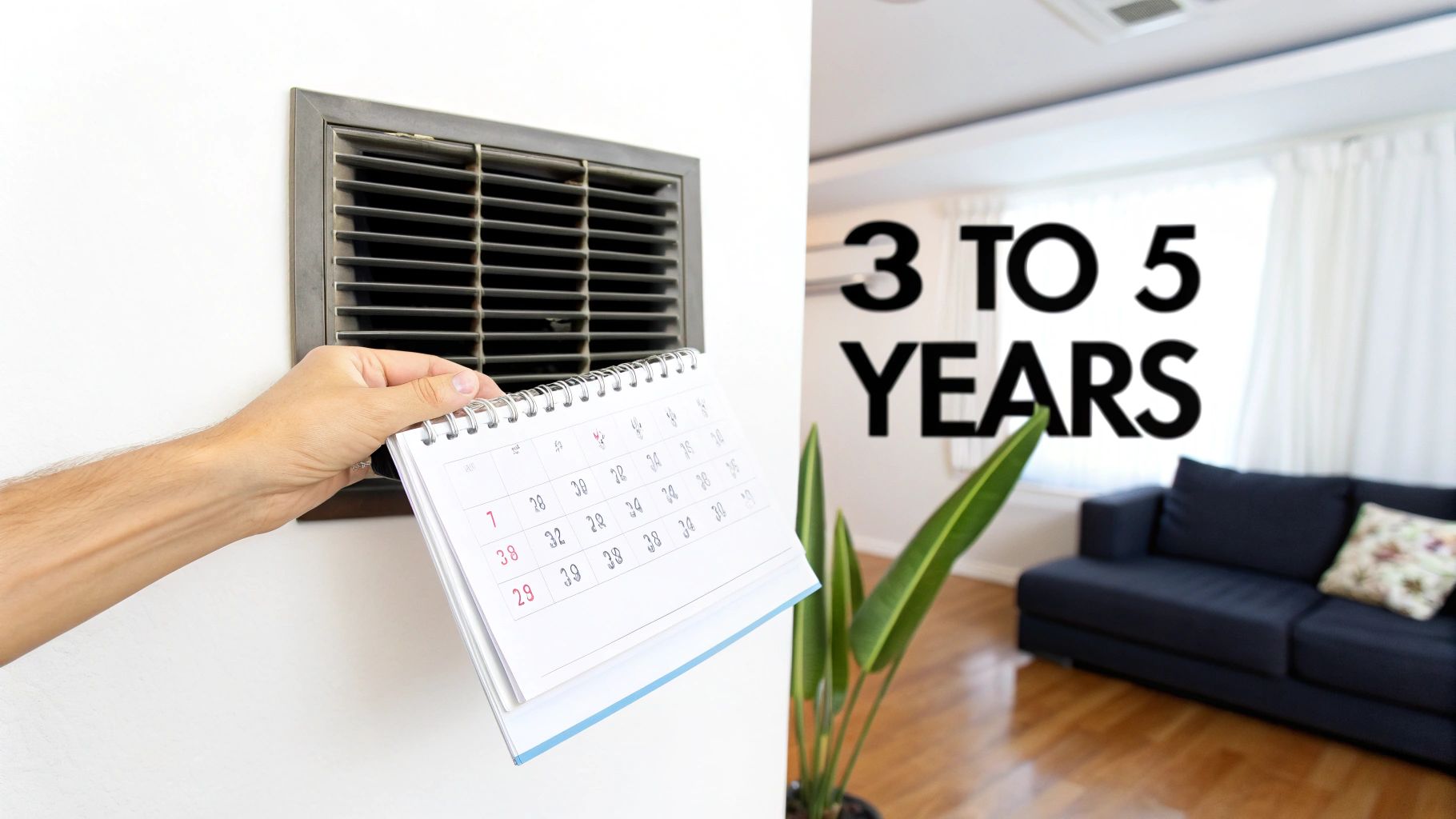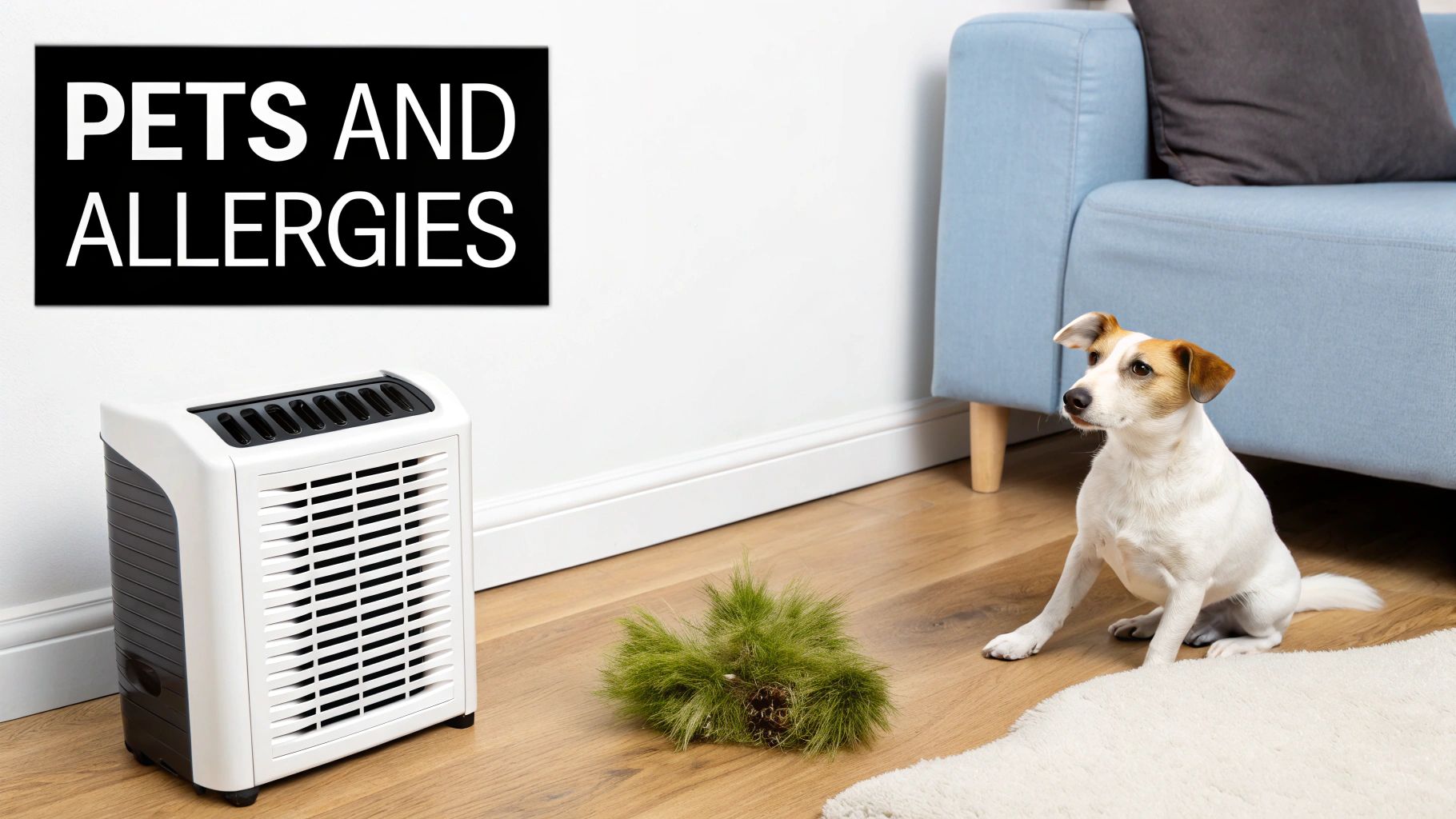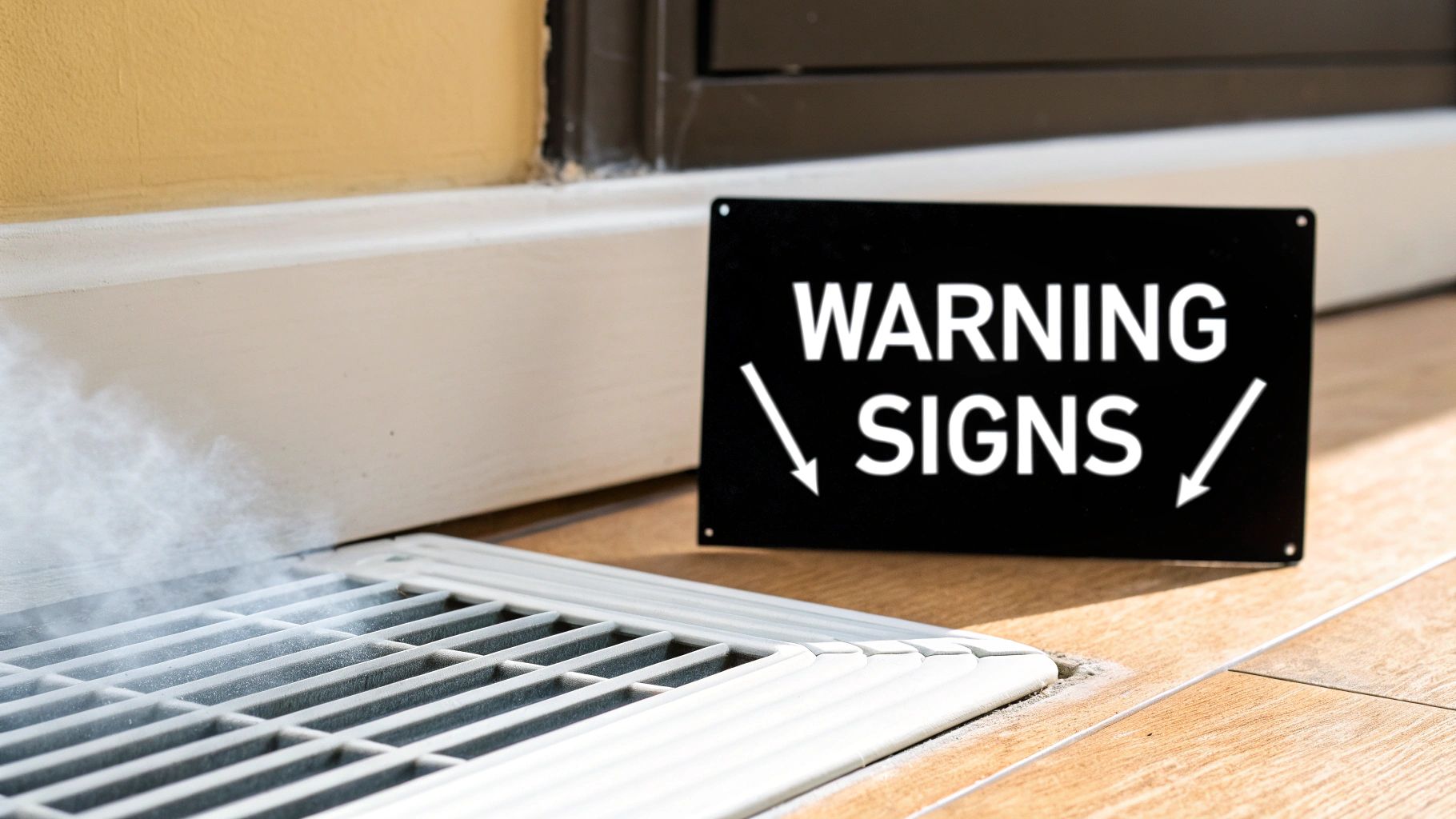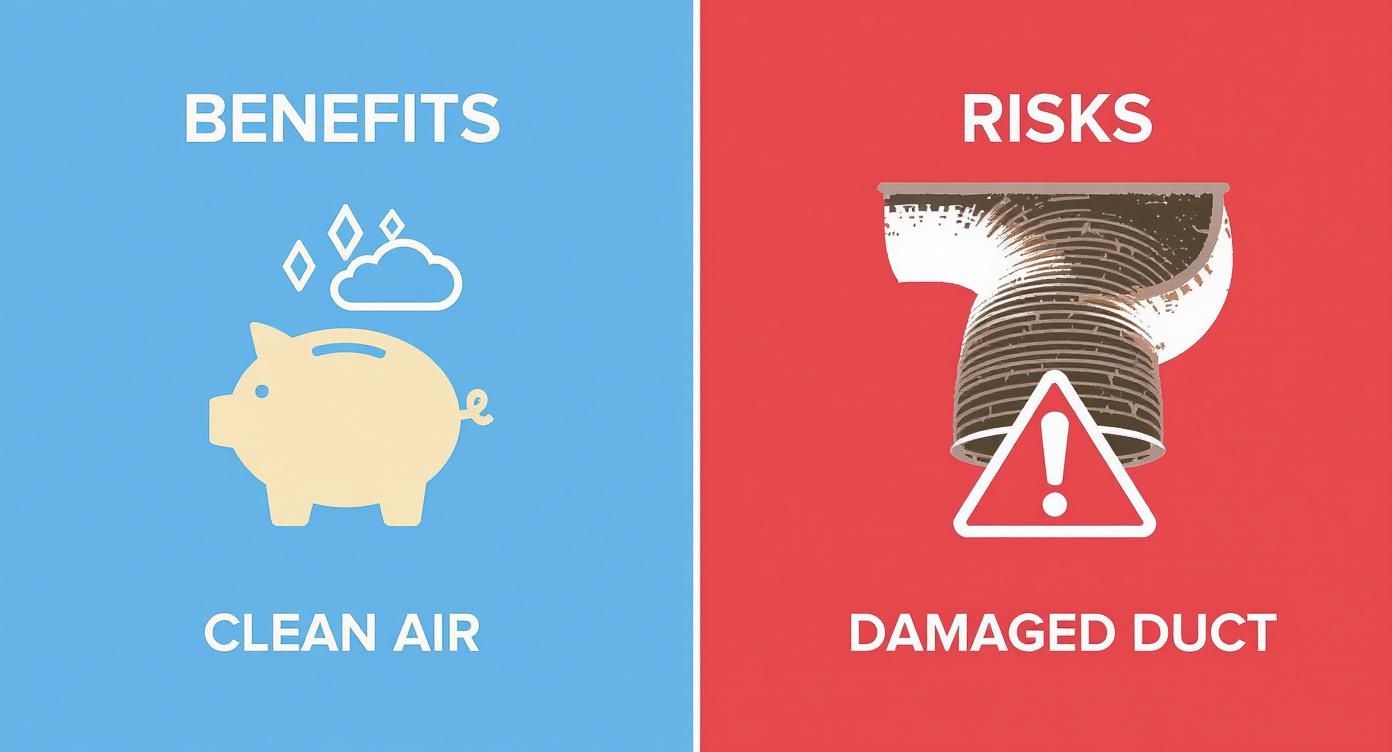When people ask me how often they should get their ducts cleaned, my go-to answer for the average home is every 3 to 5 years. It’s the sweet spot for keeping your home's air quality in check and your furnace and A/C running smoothly.
Think of it as a routine check-up for your home’s lungs. This simple schedule helps prevent major build-up before it becomes a problem.
The 3 to 5 Year Rule for Duct Cleaning and When to Break It

That 3-to-5-year window isn't just a number we pulled out of thin air. It’s the timeframe recommended by industry experts, including the National Air Duct Cleaners Association (NADCA). This standard is a solid starting point for a typical household.
But let's be real—no two homes are exactly alike. Just like you wouldn't follow the same oil change schedule for a car that sits in the garage versus one that's driven across the country, your duct cleaning schedule needs to match your lifestyle.
Your Home's Unique Timeline
Imagine your ductwork as the respiratory system of your house, constantly circulating air. For a home with no pets, smokers, or allergy sufferers, waiting five years between cleanings might be perfectly fine.
But life happens. Things change, and those changes can clog up your ducts a lot faster. Here are the big ones that tell you to clean more often:
- You have furry friends: Pet dander and fur are notorious for getting sucked into your vents and building up over time.
- Someone has allergies or asthma: Clean ducts mean fewer dust mites, pollen, and other irritants circulating in the air you breathe. It's a health no-brainer.
- You just finished a renovation: Drywall dust, sawdust, and other construction debris are incredibly fine and will settle deep inside your ductwork.
- There's a smoker in the house: Smoke residue creates a sticky, greasy film on the inside of your ducts, which then acts like a magnet for dust and dirt.
If any of these sound familiar, you should probably cut that 3-to-5-year guideline down to every 2 to 3 years. And if you want to keep things fresh between professional cleanings, check out our tips on how to maintain your air duct systems.
Here’s the bottom line: Treat the 3-to-5-year rule as the longest you should ever wait. The real answer depends entirely on what’s happening inside your home.
Duct Cleaning Frequency Guidelines At A Glance
To make things even simpler, here’s a quick chart to help you figure out a schedule that makes sense for you. Find the situation that best matches your home to get a reliable starting point.
| Household Condition | Recommended Cleaning Frequency |
|---|---|
| Standard Household (No Pets, No Allergies) | Every 3-5 Years |
| Home with One or More Pets | Every 2-3 Years |
| Residents with Allergies or Asthma | Every 2-3 Years |
| After Major Home Renovations or Construction | Immediately After Project Completion |
| Household with Indoor Smokers | Every 2 Years |
| Moving into a Previously Owned Home | Before or Immediately After Moving In |
This table should give you a much clearer idea of when to book your next cleaning. When in doubt, it never hurts to have a professional take a look.
How Your Lifestyle Impacts Duct Cleaning Frequency

The standard 3-to-5-year guideline for duct cleaning is a great starting point, but it really only applies to an "average" home. Think of it like an oil change sticker on your car's windshield—it’s a solid recommendation for typical driving, but if you’re constantly stuck in stop-and-go traffic or driving on dusty roads, you’ll need to change it sooner.
It’s the same with your ducts. Certain lifestyle factors can dramatically speed up the accumulation of dust, dander, and other gunk in your ventilation system, meaning you'll need to be more proactive. Let’s dig into the common culprits that might put your home on the fast track for a cleaning.
Homes with Furry Family Members
We love our pets, but let's be honest—they're little fluff-and-dander machines. Every bit of hair and those tiny skin flakes (dander) get sucked right into your HVAC system, where they build up over time. It’s not just about what you see on the floors; it's about what's accumulating out of sight.
This buildup can eventually clog your system, making it work harder and less efficiently. More importantly, it creates an all-you-can-eat buffet for dust mites. For homes with pets, especially heavy shedders, waiting five years is just too long. We strongly recommend a cleaning every 2 to 3 years to keep those pet-related allergens in check. If you’re fighting the good fight against fur, it's also worth learning how to get rid of pesky pet dander between professional visits.
Prioritizing Health for Allergy and Asthma Sufferers
If anyone in your family deals with allergies, asthma, or other respiratory issues, your ductwork plays a huge role in their daily comfort. When clean, your HVAC system helps filter the air. But when it's dirty, it becomes a delivery service for every trigger imaginable—pollen, mould spores, dust mites, you name it.
Each time the heat or AC kicks on, it blasts these settled irritants back into your rooms, which can lead to a flare-up of symptoms. Shortening your cleaning schedule to every 2 to 3 years can make a world of difference, helping create a healthier sanctuary for everyone at home.
A clean HVAC system is a foundational component of a healthy home. For those with respiratory conditions, frequent duct cleaning isn't a luxury—it's an essential part of managing their environment and well-being.
The Non-Negotiable Post-Renovation Cleaning
Home renovations are fantastic… until the dust settles. And it settles everywhere, especially deep inside your ductwork. That ultra-fine dust from drywall, sanding, and sawing is the absolute worst offender for clogging up an HVAC system.
If you don't get your ducts cleaned right after a reno, you’re basically signing up to breathe in construction debris for years. It’s not just gross; that gritty dust can put a serious strain on your furnace and AC.
- Immediate Cleaning: The best time to book a cleaning is right after the contractors have packed up, but before you start living in the new space.
- Comprehensive Removal: This is not a DIY job. You need professional equipment to pull out all those fine, abrasive particles hiding in the corners and crevices of your duct system.
- System Protection: A thorough cleaning protects your HVAC investment by preventing that nasty dust from damaging sensitive components like the fan motor and evaporator coil.
Other Important Lifestyle Considerations
Beyond those big three, a few other factors can move up your cleaning date.
If someone smokes indoors, the sticky residue from smoke coats the inside of your ducts, acting like flypaper for every piece of dust that floats by. In this case, cleaning every 2 years is a must. Living in the GTA also means dealing with high pollen seasons and urban pollution, both of which add to the contaminant load in your home and justify a more frequent cleaning schedule.
Warning Signs Your Air Ducts Need Cleaning Now

While the 3-to-5-year schedule is a great rule of thumb, sometimes your home sends up a flare, signalling that your ducts need attention right now. Ignoring these hints can tank your air quality, inflate your energy bills, and put a lot of strain on your HVAC system.
Think of it as your home trying to tell you it can't breathe. Learning to read these clues helps you get ahead of problems before they spiral out of control. Let's look at the signs—both obvious and subtle—that it's time to bring in a pro.
Visible Dust and Debris
This one is the most in-your-face clue. If you see little puffs of dust shooting out of your vents when the furnace or AC kicks on, that’s a dead giveaway your ductwork is overloaded. You might also spot a thick layer of dust and cobwebs clinging to the vent covers themselves.
Don’t just wipe it clean and call it a day. That visible gunk is just the tip of the iceberg. It’s a clear sign the whole system is saturated with contaminants that are now being blasted into your living space. For a closer look, you can check out more signs that you need to get your air ducts cleaned in our detailed guide.
Unpleasant Odours and Mould Growth
Your nose knows. If a persistent musty or mildewy smell wafts through the house every time the system runs, you've likely got a moisture problem somewhere in the ducts. That damp, dark environment is a five-star resort for mould and mildew, which then gets circulated everywhere.
Keep an eye out for visible mould growth on or around your vent registers—it can look like black, green, or even white specks. Any hint of mould is an urgent call for help, as those airborne spores can create serious health risks.
If you can see mould or smell that distinct musty odour coming from your vents, don't wait. This is a critical warning sign that your ducts need immediate professional attention to protect your family's health.
Skyrocketing Energy Bills
Have your hydro bills suddenly shot through the roof for no apparent reason? Your dirty ducts could be the culprit. As dust, dirt, and debris build up inside, they choke off the airflow, forcing your HVAC system to work much harder to keep your home comfortable.
It’s like trying to breathe through a clogged straw. Your system has to run longer and harder just to do its job, which sends your energy consumption—and your bills—soaring. A professional cleaning clears out those blockages, letting air move freely and getting your system back to peak efficiency.
Evidence of Pests
Unfortunately, your ductwork can sometimes become a superhighway for rodents and insects. If you hear scratching or scurrying sounds inside your walls or find droppings and bits of nesting material near your vents, you’ve got an infestation on your hands.
Pests in your vents are a major health hazard, introducing bacteria, viruses, and allergens directly into the air you breathe. This isn't just a cleaning job; it demands immediate professional help to both clean the ducts and deal with the pests so they don't come back.
The Real Value and Risks of Duct Cleaning
So, is duct cleaning actually worth it? The honest answer is: it depends entirely on who does the job. When done right by a certified professional, the benefits are real and tangible. But a botched job can leave you worse off than when you started.
Let's talk about the good stuff first. The biggest win is a massive improvement in your indoor air quality. Over the years, your ductwork becomes a hidden reservoir for dust, pollen, pet dander, and even mould spores. Every time your furnace or AC kicks in, it circulates these contaminants throughout your home. A professional cleaning physically removes this buildup from the source, giving you and your family cleaner, healthier air to breathe.
The second major perk is a boost in HVAC efficiency. Picture your ducts choked with debris—it's like trying to breathe through a clogged straw. Your system has to work overtime just to move air, which drives up your energy bills and puts a ton of strain on expensive equipment. Clearing out that gunk lets your HVAC system breathe easy, run more efficiently, and last longer.
The Dangers of a Bad Cleaning
Now for the flip side. The duct cleaning industry is unfortunately full of "blow-and-go" outfits that can cause more harm than good. Hiring one of these cut-rate companies is where the real risk lies.
Their sloppy techniques can dislodge settled dust without actually capturing it, blasting it straight into your living space. Even worse, an untrained technician with aggressive tools can easily tear or puncture your ductwork. These new leaks not only sabotage your system's efficiency but can also start pulling in dirty, unconditioned air from your attic or basement.
If you're wondering about the cost versus the payoff, you can dive deeper into whether professional duct cleaning is worth the investment in our detailed guide.
Here’s the bottom line: The success of a duct cleaning is 100% dependent on the quality of the provider. The risks aren't in the service itself, but in who you hire to perform it.
Choosing a Professional vs DIY Duct Cleaning
Making an informed decision is your best defence. A certified, insured, and experienced company will use powerful, contained vacuum systems to ensure dust and debris are pulled out of your home, not just shuffled around. They know how to handle different types of ductwork without causing damage.
To put it in perspective, here’s a quick look at what you get when you hire a pro versus trying to tackle it yourself or hiring a cheap operator.
| Aspect | Professional Service (NADCA Certified) | DIY Approach |
|---|---|---|
| Equipment & Power | Truck-mounted, high-powered vacuums and specialized agitation tools designed for ductwork. | A shop vac with a long hose—nowhere near powerful enough to clean the entire system. |
| Contaminant Control | Creates powerful negative pressure, pulling all debris directly outside to the truck. | Often just pushes contaminants deeper into the system or blows them into the room. |
| Risk of Damage | Extremely low. Technicians are trained to safely clean all types of duct materials. | Very high. It's easy to puncture flexible ducts or damage internal HVAC components. |
| The Final Result | A comprehensive cleaning that measurably improves air quality and system efficiency. | A superficial clean that misses most of the buildup and can actually make air quality worse. |
When you get down to it, investing in a reputable, certified service is the only way to avoid the risks and actually get the benefits of cleaner air and a more efficient home.
What a Professional Duct Cleaning Should Involve
Knowing what a thorough, professional duct cleaning actually looks like is your best defense against scams. A reputable service isn't just about a guy showing up with a Shop-Vac; it's a systematic process designed to genuinely improve your air quality and protect your home in the process. When you understand the steps, you can ask the right questions and hire with confidence.
The whole thing starts long before any equipment gets turned on. A true pro will begin with a comprehensive visual inspection, checking out your ductwork, registers, and the HVAC unit itself. They’re looking for the level of contamination and trying to spot any underlying issues, like leaks or damage, that need attention. This isn't a step to be skipped—it sets the stage for everything that follows.
After the inspection, the technicians will carefully prep your home. This means protecting your floors and furniture with drop cloths and sealing all your supply and return vents with adhesive covers. It's a critical step to ensure that all the gunk they dislodge during the cleaning doesn't get blown right back into your living space.
Creating Negative Pressure
The cornerstone of a proper job is creating negative air pressure within your HVAC system. To do this, technicians connect a massive, powerful vacuum collection unit to your main duct lines, usually right near the furnace. Once this beast is fired up, it pulls all the air, dust, and debris from the entire ductwork system directly into a contained unit, typically outside your home.
This powerful suction ensures that as contaminants are broken loose inside the ducts, they only have one place to go: out of your house. It’s the single most important element that separates a real cleaning from a superficial one.
The Agitation Process
With the system under constant negative pressure, the real cleaning can begin. Technicians will work through your home, unsealing one vent at a time. They use a whole arsenal of specialized tools to agitate and dislodge caked-on dust and debris from the inner surfaces of the ducts.
These tools often include:
- High-Powered Air Whips: Think of long, flexible rods with multiple whipping lines that spin like crazy to scrub the inside of the ductwork clean.
- Spinning Brushes: For the really stubborn, heavy buildup, motorized brushes of various sizes are used to break it loose.
- Compressed Air Nozzles: These tools blast concentrated streams of air to push every last bit of debris toward the main vacuum line.
It's this combination of aggressive agitation and powerful suction that effectively removes years of accumulated gunk. Once a duct run is clean, the vent is resealed, and the technician moves on to the next one, repeating the process until your entire system is spotless.
The infographic below really drives home the difference between a professional service and the risks of a poor-quality job.

As you can see, the value you get from a duct cleaning is directly tied to the quality and professionalism of the company you hire.
Final Steps and System Check
Even after all the ducts are cleaned, the job isn't quite done. A reputable company will also clean other key components of your HVAC system—like the blower motor, fan, and evaporator coil—since these parts get just as dirty. Finally, they’ll remove all their equipment, unseal your vents, and perform a final system check to make sure everything is running perfectly.
When you're choosing a service, a company with a strategic HVAC website design often signals a commitment to professionalism and clear communication. Knowing what to expect makes all the difference, and a little prep work can also streamline the process. You can learn more by checking out our guide on preparing your house for a duct cleaning service.
Common Questions About Duct Cleaning Schedules
Even after learning the signs and steps, most homeowners still have a few lingering questions. That's perfectly normal. Getting straight answers helps you feel confident about when—and why—you’re calling in a pro. Let's clear up some of the most common ones.
Can I Just Change My Furnace Filter Instead of Cleaning Ducts?
Changing your furnace filter is non-negotiable for basic air quality, but it’s only half the battle. Think of your filter like the doormat at your front door—it catches the obvious dirt and debris before it gets tracked all through the house. It's your first line of defence.
But over the years, the really fine stuff—dust, dander, allergens—inevitably sneaks past. It settles deep inside your ductwork, far out of the filter's reach. A professional duct cleaning is like getting the entire house deep-cleaned, reaching all the hidden corners and ensuring the whole system is fresh from the inside out.
How Much Does Professional Duct Cleaning Typically Cost?
Here in the Greater Toronto Area, the price tag for a thorough, professional duct cleaning depends on the size of your home, how many vents you have, and the overall complexity of your HVAC system. You should generally budget somewhere between $400 and $1,000 for a job done right.
Be very wary of deals that sound too good to be true, especially anything advertised for under $200. These are almost always a "bait-and-switch" tactic from operators who do a quick, superficial job that provides zero real benefit.
Always get a detailed, written quote from a certified and insured company before they start working. It’s the best way to protect yourself and know exactly what you’re paying for.
Is Duct Cleaning Really Necessary or Just a Scam?
This is a big one. Duct cleaning is absolutely a legitimate and valuable service—when it's done by a certified professional for the right reasons. The whole "scam" reputation comes from sketchy operators who do a shoddy "blow-and-go" job, take your money, and leave you with ducts that are just as dirty as before.
The key is knowing when it’s truly needed. A cleaning is definitely warranted if you see:
- Visible mould growing in or around your vents.
- Signs of a pest or rodent infestation in the ductwork.
- Thick layers of dust and debris clogging the system or blowing out of your registers.
For homes with family members who have bad allergies, homes with multiple pets, or after a major renovation, a proper cleaning can make a world of difference in your indoor air quality. To avoid getting scammed, just steer clear of those unbelievable low-price offers and unsolicited phone calls. Always hire a NADCA-certified professional who offers transparent pricing and can show you proof of their work.
Ready to ensure the air in your GTA home is as clean as it can be? The experienced team at Can Do Duct Cleaning is here to help. Schedule your professional duct cleaning service today


